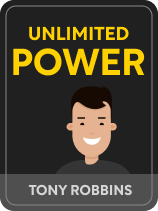

This article is an excerpt from the Shortform book guide to "Unlimited Power" by Tony Robbins. Shortform has the world's best summaries and analyses of books you should be reading.
Like this article? Sign up for a free trial here.
What are your goals in life? How do you keep pushing forward toward your most ambitious goals in spite of the setbacks that get in the way?
The first step to reaching your goals is to know what you actually want: You can’t reach a destination if you don’t know where you are heading. From there, it’s all about riding the momentum.
With this in mind, here’s how to reach your goals in four simple (but not so easy) steps.
Step 1: Decide What You Want
Before you can start working toward reaching your goals, you need to know what you’re working toward. Robbins says that an effective goal must be clear, ambitious yet achievable, and most importantly, inspirational. That last point is crucial because, no matter how much energy you have, you won’t want to put any of it toward a goal that doesn’t excite you.
(Shortform note: Robbins suggests setting goals that are challenging enough to inspire you but not so hard that they become frustrating or disheartening. In The 10X Rule, Grant Cardone suggests a different approach: Think of a realistic goal, then multiply it by 10. For example, if your “reasonable goal” is to retire in 20 years, your 10X goal—doing it 10 times faster—would be to retire in two years. Cardone’s reasoning is that a 10X goal will drive you to work hard, and even if you fall short, you’ll still have achieved more than if you’d reached a mediocre goal.)
Step 2: Get Started
Once you have a goal in mind, figure out a course of action that seems likely to get you closer to that goal, then take that course. Robbins emphasizes this step very strongly; no matter how much you want something or how carefully you plan, you’ll never get closer to your goals unless you take action.
(Shortform note: In Extreme Ownership, former SEAL officers Jocko Willink and Leif Babin explain how to effectively create and carry out a plan of action. Once you’ve set your goal, take stock of your available resources (time, money, other people, and so on), and consider the best ways to use each of those resources. Brainstorm multiple different plans, then pick one and fully commit to it—once you’ve chosen a plan, the time for worrying about whether it’s the best possible plan is over.)
Step 2.5: Fearlessly Work With Others
There are few goals, if any, that you can accomplish completely on your own. Somewhere along the way, you’ll need support, advice, or approval from someone else, and any interaction with another person carries the possibility of being rejected. That’s why one of Robbins’s essential tips is: Don’t fear rejection.
Rejection can be painful, but you mustn’t let the fear of it stop you from doing whatever’s necessary to reach your goals. Remember: Some of the world’s most famous artists, actors, and musicians spent years experiencing rejection after rejection before they finally found success.
(Shortform note: Doctors say that, psychologically, people respond to rejection the same way that they respond to physical pain. Therefore, people avoid situations in which they’re likely to be rejected in the same way that they avoid situations in which they’re likely to be injured. In fact, the psychological responses are so similar that Tylenol has been shown to reduce the frequency and severity of hurt feelings. With that said, doctors don’t recommend using painkillers to cope with rejection—instead, they suggest having a support network of friends or family members whom you can turn to when you’re chasing your goals and suffering from rejection.)
Step 3: Gauge Your Progress
Once you’ve started your plan of action, regularly review your progress toward your goal and consider whether each action so far has served you well. Whether it was a simple conversation, a business investment, a workout, or just a daily habit, determine whether each action got you closer to your goal or farther from it.
Robbins adds that, in many cases, other people’s responses to your actions will be the best indicator of whether or not you’re getting closer to your goals. Did people respond positively or negatively to what you did?
| Plan Your Evaluation First To effectively evaluate your results, you first need to determine what you’ll be evaluating and how. In other words, decide beforehand how you’ll know whether your actions are getting you closer to your goal or farther from it. Robbins suggests using the reactions of people around you as your metric for success, but that isn’t always applicable. For example, if your goal is to save up enough money to retire, then you can use your savings and investments as your measure of success—anything that helps you put aside more money is getting you closer to your goal. On the other hand, if your goal is to improve your physical fitness, you could use weekly measurements like weight, waist size, and how much weight you can lift to determine your progress toward or away from that goal. |
Step 4: Change What’s Not Working
If you determine that an action got you closer to your goal in some way, then continue doing it. However, if it didn’t, then you must be flexible enough to change your approach. Reexamine your actions and see if you can determine what went wrong; if necessary, recheck your mental program against the person you’re imitating to make sure it’s accurate. Keep evaluating and adjusting your actions however many times it takes to start getting the results you want.
(Shortform note: Even if you know that your plan didn’t work, it can be difficult to pinpoint what went wrong or how to fix it. In these situations, one of the most important things you can do is to stay true to your values. Since you’ve chosen values and goals that complement one another, examining how your actions might have gone against those values could provide valuable clues about why your plan didn’t work. Furthermore, adjusting that plan to bring it more in line with your values will make you more likely to reach your goals.)
This brings us to another of Robbins’s essential tips: Learn to cope with aggravating setbacks. Nothing great was ever achieved smoothly and easily. The world’s top achievers in any field—business, sports, science, art, and so on—went from mistake to mistake and defeat to defeat on their way to success. So, no matter how many times you have to adjust your plan and try again, remember that the only true failure is giving up.
(Shortform note: Experts offer numerous different tips on how to cope with frustration, but they generally boil down to either burning off the negative energy or refocusing your mind away from the feelings of frustration. Some suggested methods are exercise, meditation, and distracting yourself with an activity you enjoy.)
Another of Robbins’s essential tips is that you mustn’t let yourself stagnate. Once you accomplish a goal, start thinking about the next one—use the momentum you’ve built to keep improving yourself, rather than resting on your laurels and losing the energy you worked so hard to create.
(Shortform note: One method for building and maintaining momentum is what Robin Sharma (The Monk Who Sold His Ferrari) calls kaizen, which is a Japanese word meaning “continuous improvement.” The idea behind kaizen is that each day, you should become a little better at something than you were the day before; as Robbins would say, each day, you should get a little closer to one of your goals. Sharma’s suggestion is to identify your greatest weaknesses—perhaps low energy, a lack of confidence, or insufficient practice with some key skill—and work on improving a little bit each day until you overcome those weaknesses.)

———End of Preview———
Like what you just read? Read the rest of the world's best book summary and analysis of Tony Robbins's "Unlimited Power" at Shortform.
Here's what you'll find in our full Unlimited Power summary:
- How to harness your thoughts and beliefs and turn them into purposeful action
- How to find even greater success through cooperation and leadership
- How you can use your successes to help others and improve the world






